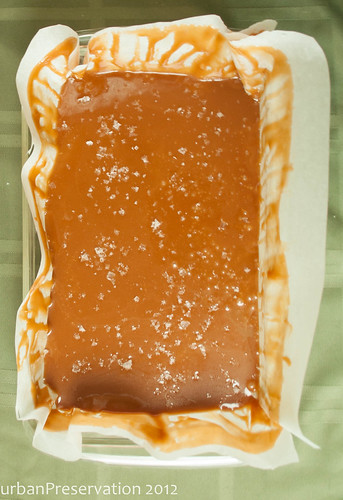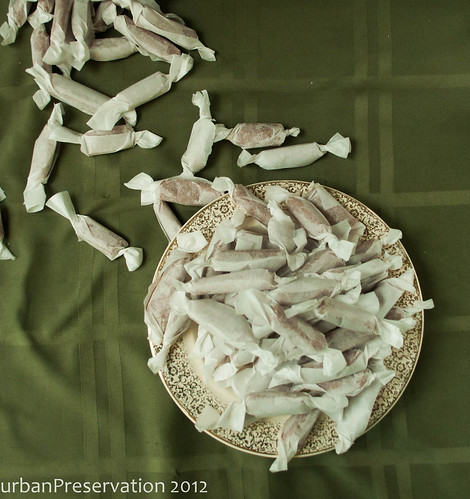
Candy making is not very difficult since it’s mostly playing with sugar temperatures to manipulate the granules into a different texture. The problems lies not in its complexity but the fact that sugar burns and it also takes a while to heat up, increasing the chance that you will lose interest and walk away only to return to find sugar burned to the bottom of a pan. But home candy making is not something you should be intimidated about. It does require some special equipment (a candy thermometer) but it’s a relatively easy task once you have that. Plus, the cost of messing up a batch is pretty small – just a few cups of sugar are wasted since it’s generally in the sugar cooking stage that things tend to go wrong. The real key here is: don’t walk away from the stove. Just don’t. It might be boring to stand and watch the sugar darken but if you walk away it will burn. Make a game of it, dance around, practice counting in foreign languages, whatever you have to do; but don’t walk away.

The 1000 pound gorilla in the room when it comes to home candy making is corn syrup. Yes, corn syrup is in most recipes for home candy making. The problem is that while sugar can be melted into a liquid to form a chewy delicious treat, it really wants to stay in granule form. So if the pan is moved too much when you make the candy, the sugar has a tendency to recrystallize, thus ruining all your hard work. Using corn syrup, or any liquid sweetener high in glucose, helps prevent that recrystallization since glucose doesn’t crystalize. But with all the concerns about high fructose corn syrup (which is not the same as home use corn syrup), and the fact that most plain corn syrup is made with GMO corn, it can be a sticky subject. I’m not saying I don’t cook with corn syrup – in some cases it’s really the only option for high glucose liquid sweetener – but when I can find a way to avoid it, I will.

In the case of these caramels, honey plays the role of high-glucose liquid sweetener to prevent your chewy sweets from becoming full of hard sugar crystals. The end result is definitely honey flavored which is a nice added dimension to these sweets. It’s also a great beginner caramel recipe since the honey adds some color to the caramel so you don’t need to cook the sugar as much to get a deep golden color. I’ve been enjoying these for two weeks now and they’re still just as chewy and delicious as the first day.
Worried about cleaning that pan? Don’t be – place all your sugar-coated implements (no judgment; just getting clean) into the caramel pan and put it all in the sink. Boil a kettle of water and pour the just-boiled water into the pan, making sure to get all the little splashes of caramel. Let it sit for a few minutes, then give everything a gentle scrub. Clean pan, delicious candy, no sweat.

Honey Salted Caramels
Adapted from Chez Pim
1 ½ cups sugar
½ cup honey
1 cup heavy cream
½ stick (4 oz) butter, softened to room temperature, cut into half-inch cubes
1 tsp kosher salt plus additional for sprinkling.
Pour cream into a small saucepan and put on very low heat to simmer.*
Place honey and sugar in a pot over medium heat. Cook until caramelized to the color you want in your caramels. Shake or swirl the pot to get sugar crystals to melt but don’t stir – that encourages recrystallization.
When the sugar reaches your desired color, whisk in butter a few pieces at a time. Once all the butter is incorporated, whisk in the cream and add salt.** Attach your candy thermometer to the pan and cook the mixture until it reaches 260F.
Pour the hot caramel onto a baking sheet lined with parchment paper. Cool for 8-10 minutes, then sprinkle evenly with salt; I used Maldon sea salt. Let caramels cool completely, 3-6 hours, before cutting. Cut into bite-sized pieces with scissors or a well-greased knife. Wrap individual caramels in parchment or waxed paper.
*Adding cold cream to the caramels will cause the caramel to seize and the cream to curdle.
**When the cream is added the mixture will bubble up a bit. Be prepared.
No comments:
Post a Comment